What the Sun Is Made Of
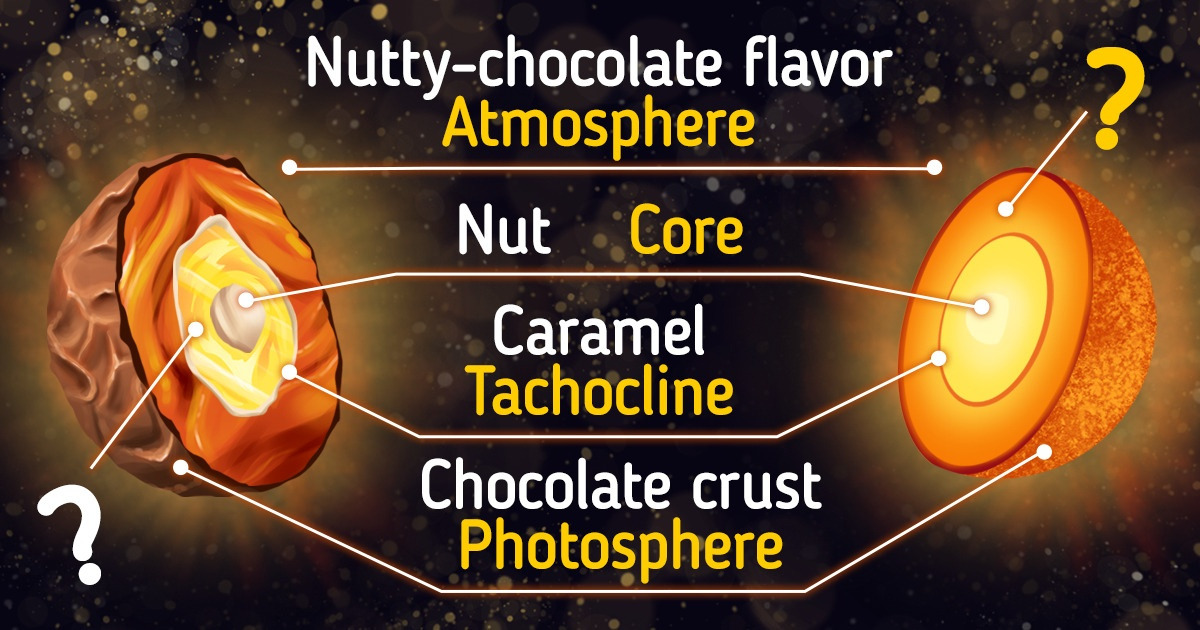
5-Minute Crafts is going to tell you what one of the most important space objects for humanity is made of.
The Sun Is a Star
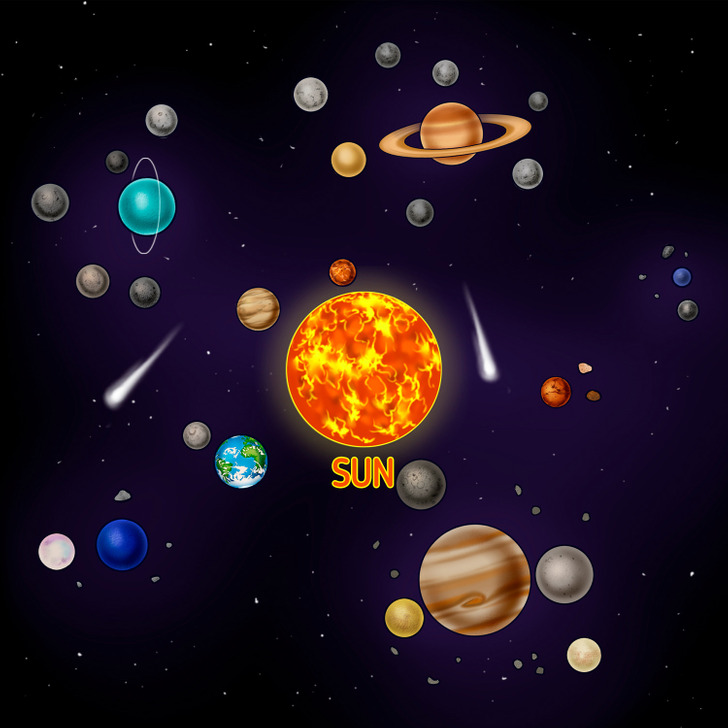
The Sun is a 4.5 billion-year-old star (a hot glowing ball of hydrogen and helium). It’s the largest object in our entire solar system and our source of life. To put things in perspective:
- The total volume of the Sun is 1.4×1027cubic meters. About 1.3 million Earths could fit inside the Sun.
- The width of the Sun is 100 times more than that of the Earth and 10 times more than the width of the biggest planet in the solar system — Jupiter.
- The mass of the sun is 1.989×1030 kilograms, about 333,000 times the mass of the Earth.
Absolutely everything revolves around the Sun thanks to its gravity: pieces of space debris, 8 planets, 5 dwarf planets, thousands of asteroids, and around 3 trillion comets and icy bodies.
It’s not surprising that the entire system is named after the Sun because its mass is 99.8 % of the mass of the solar system itself.
Despite how we see and picture the Sun, its color is actually white, not yellow.
How the Sun affects the Earth
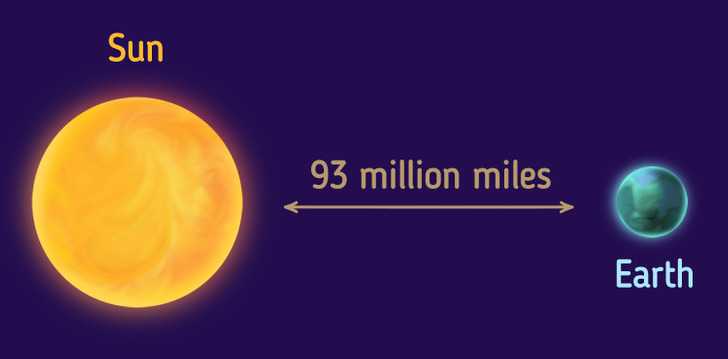
The Sun’s activity, from the eruptions to the streams of particles affects the entire solar system, including our planet.
Even though the distance between the Sun and the Earth is around 150 million km (93 million miles), it has a big impact on the planet we live on, for example:
- It drives weather.
- It affects ocean currents.
- It changes seasons and the climate.
- It makes plant life possible through photosynthesis.
Life on the surface of the Sun is impossible but without this star, life on Earth would be impossible too.
There are solar flares which are basically powerful bursts of energy that can impact radio communications, electric power grids, and navigation signals.
Besides, the ultraviolet light from the Sun splits oxygen in the stratosphere and strengthens Earth’s protective ozone layer.
What the Sun is made of
Like a chocolate candy with a nut, a caramel layer, vanilla cream, a layer of fruit, and chocolate icing, the Sun has several layers in its structure.
Around 3/4 of the Sun is hydrogen which is constantly fusing together and creating helium by a process called nuclear fusion. And helium, in turn, takes up just a bit less than the other 1/4. The rest (1.69%) of the mass is different metals and gases: iron, nickel, oxygen, silicon, sulfur, magnesium, carbon, neon, calcium, and chromium.
The Sun consists of 6 main layers:
- core
- radiative zone
- convective zone
- photosphere
- chromosphere
- corona
But there are also 2 transitional layers:
Because the core, the radiative, and convective zones are inside and hidden, and the photosphere, chromosphere, and corona are on the surface and can be seen, we’ll name them inner and outer parts, respectively.
Because the surface of the Sun is liquid plasma that makes a full circle on the equator in 25 Earth days, and in 36 on the poles, measuring a day in hours on this star is impossible. It’s not rotating as a single ball.
Inner structure
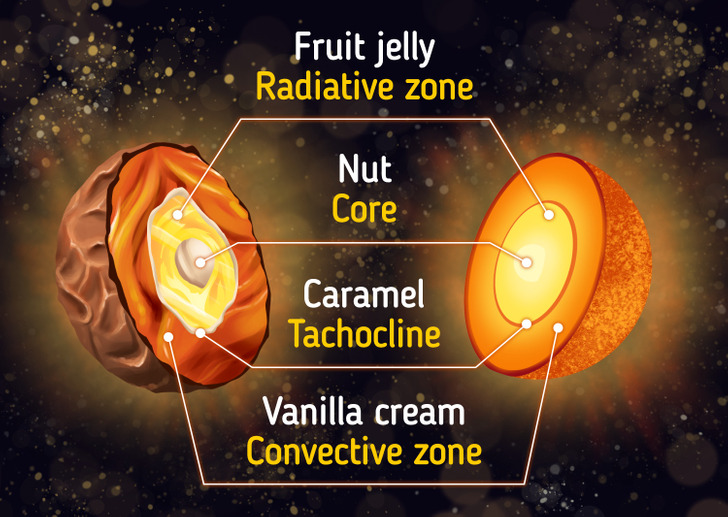
Core. This is the hottest part of the star where the temperature is 15 million degrees Celsius, 27 million degrees Fahrenheit. It’s right in the center of the Sun and is 74% hydrogen. But scientists think that in 5 billion years, the hydrogen will be burned off and the main source of heat will be helium. Thanks to the processes happening in the core, a tremendous amount of energy is produced that heats the other layers of the Sun. The core is like a nut in the middle of a piece of candy.
Radiative zone. This is where the heat from the core cools down, and the energy is transferred by a process called thermal radiation. This layer surrounds the core like a layer of fruit jelly in a piece of candy.
Tachocline. This is a transitional region between the previous layer and the next one. It is created as a result of the sun’s differential rotation. In a piece of candy, a thin layer of caramel would be in this position.
Convective zone. At this level, the temperature is lower, so the energy is transmitted through convection. This is similar to water boiling in a pot but instead of water, it’s gas that boils inside the Sun: it wants to go in the opposite direction from the core but, when it reaches the edge of the convective zone, it cools down and goes back. After that, the gas heats up again and the process repeats. This layer is like the vanilla cream right under the very crust of the candy.
Outer structure
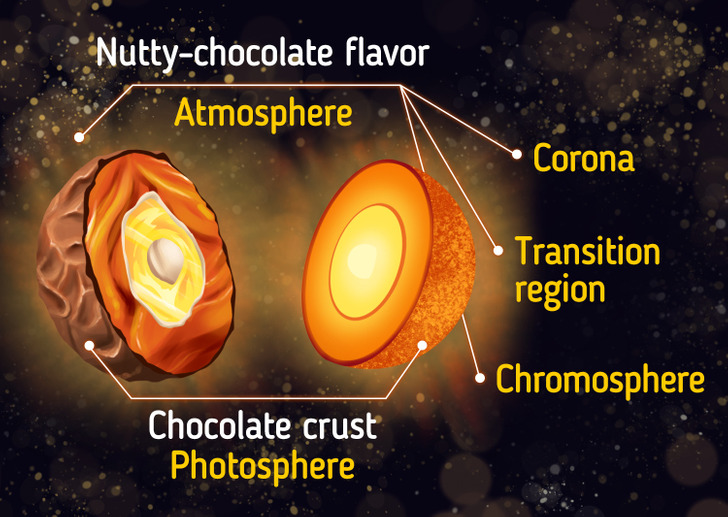
Photosphere. This is the surface of the Sun. It’s the lowermost layer of the star we can see and what we use to measure the diameter of the Sun. The photosphere is about 400 kilometers (250 miles) thick, and temperatures there reach about 5,700°C (10,300°F). Sunspots, solar flares, and prominences form in the photosphere, but they are the result of the processes happening in other layers. Like a chocolate crust, the photosphere surrounds the inner layers of the Sun.
Atmosphere. This zone unites several layers: photosphere, corona, and transitional region. The atmosphere can be seen using special devices, and you can see it with a naked eye during a solar eclipse.
Chromosphere. This is a thin layer of transparent gas above the photosphere. The chromosphere is about 2,000 kilometers (1,250 miles) thick and riddled with jets of hot gas. It has a pinkish color and the temperature rises with height.
Transition region. This is the area between the chromosphere and corona. The layers below this region are under the influence of gravity, gas pressure, and energy exchange. And those above are dominated by magnetic forces.
Corona. This is the topmost part of the atmosphere where you can see the features like solar prominences, flares, and coronal mass ejections. It’s the outermost layer of the solar atmosphere and it can extend millions of kilometers into space. Gases in the corona burn at about 1 million degrees Celsius (1.8 million degrees Fahrenheit) and move about 145 kilometers (90 miles) per second. You can see the corona with your naked eye during a full solar eclipse.